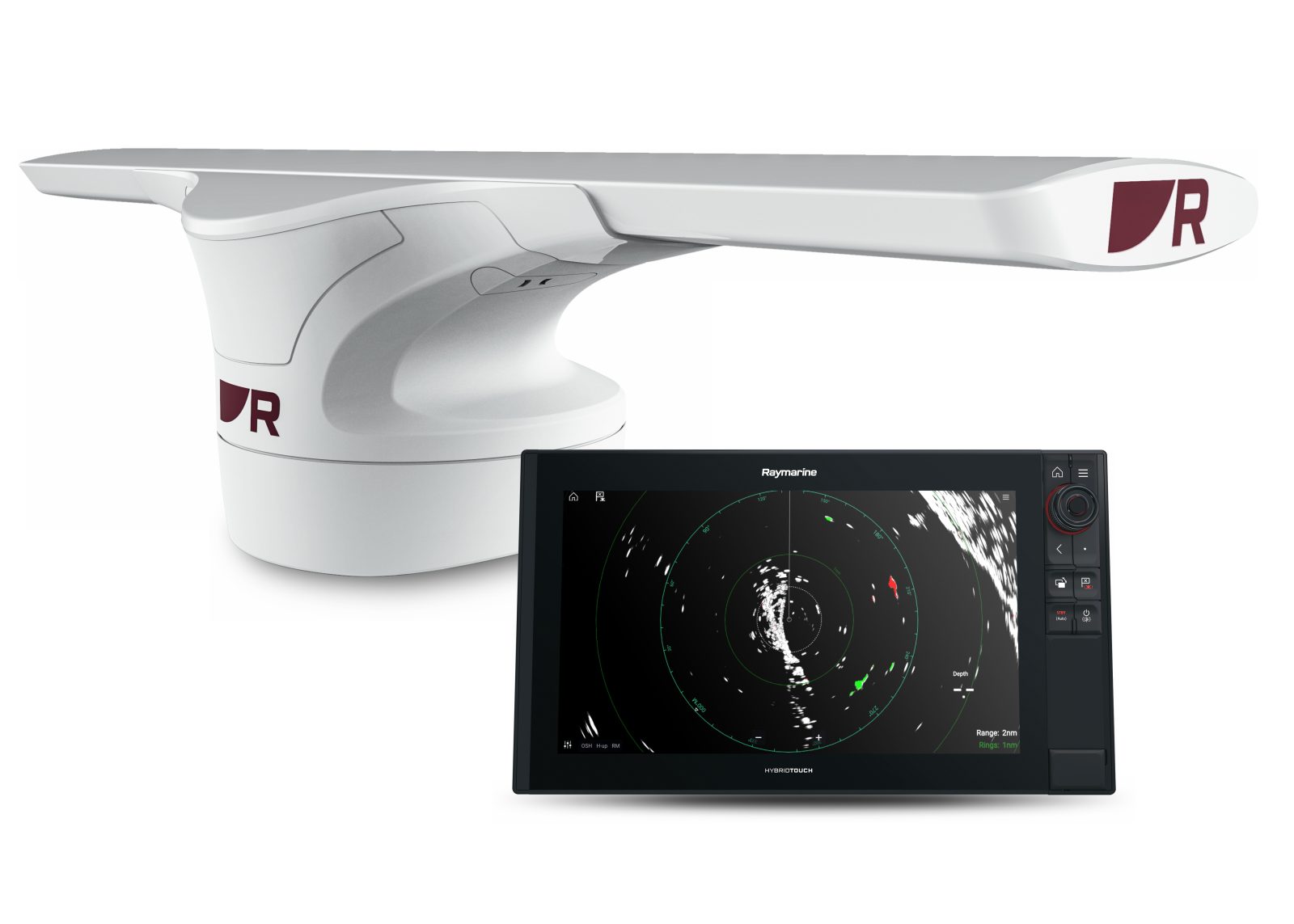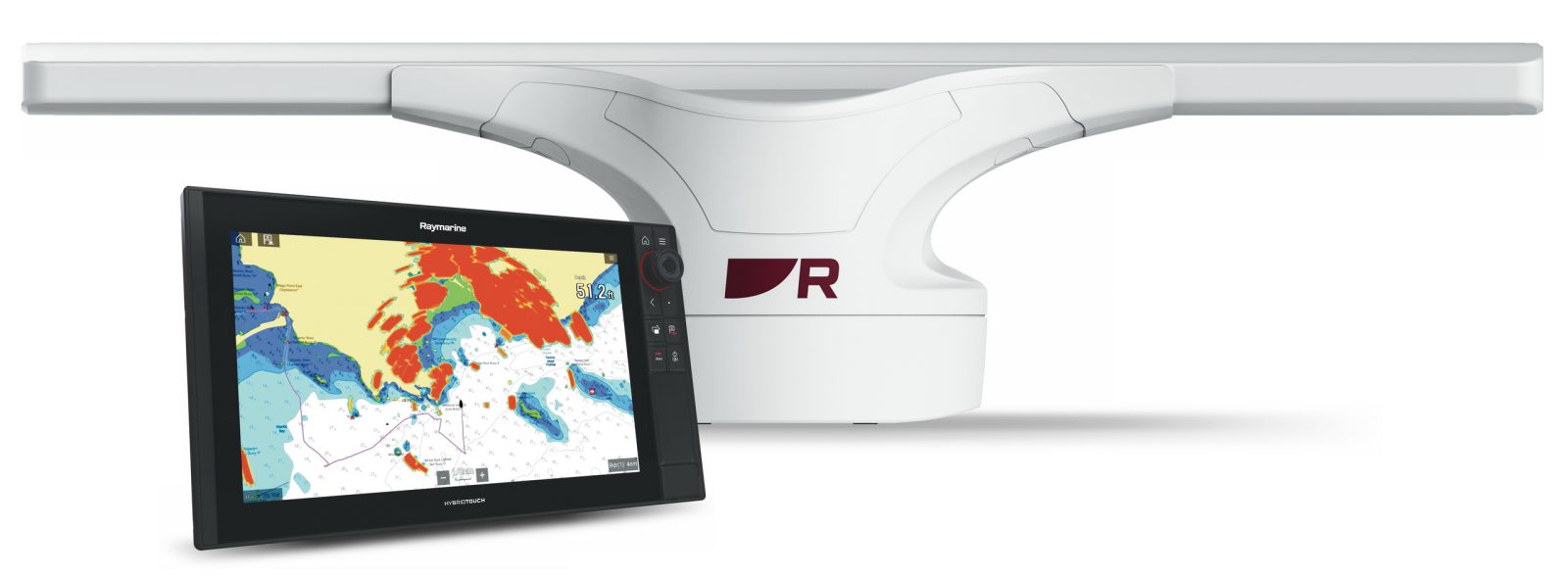Raymarine Introduces Cyclone Solid-State CHIRP Pulse Compression Radars

Striking form, extreme capability, and ruggedness are the hallmarks of this next-generation open-array radar
Nashua NH- October 26th, 2021 – Raymarine announces Cyclone, the newest range of open-array radars, conceived and crafted to give mariners the confidence to tackle the harshest conditions, gain distinct advantages in the hunt for fish, and safely navigate busy waterways. All-new Cyclone radars are available in 3-, 4- and 6-foot arrays and two high-power output options for each size. Each model features innovative detection technologies, including Cyclone Bird Mode, that elevates Cyclone into a class all its own.
Cutting-Edge Design
Cyclone’s aggressive aircraft-wing-inspired design will appeal to the most style-conscious boaters while affording new levels of functionality and performance. At just 13.2” high, Cyclone’s lower profile allows greater flexibility of boat architecture and more adaptable installation options. Cyclone is the lightest open-array radar available, with 3’ models weighing just 51 pounds. These powerful, compact options bring Cyclone’s unique open-array performance to nearly any vessel.
Maximum Capability and Awareness at Any Speed
Cyclone is engineered for extremes with a best-in-class wind rating of over 100 knots. A fast 60-RPM rotational speed delivers 360-degrees of awareness and accurate tracking of up to 100 distinct ARPA targets in real-time, even with the vessel at full speed. Precision radar imaging comes courtesy of CHIRP pulse compression and beam-sharpening technology for best-in-class target separation and long-range resolution. With Cyclone, boaters can simultaneously enjoy maximum visibility of near and distant targets using Raymarine’s RangeFusion technology. RangeFusion technology merges short-pulse near-target ranges with long-pulse, distant target ranges, providing a single radar image that is easier to interpret.
Bird Mode Fishing Intelligence
When it’s time to find fish and get to them fast, Cyclone’s Bird Mode identifies distant flocks of sea birds above baitfish schools. Bird mode intelligently optimizes radar gain and sea clutter controls for targeting seabirds, giving anglers the intelligence they need to locate baitfish and their trophy predators.

Choose Your Cyclone
The Cyclone family delivers six high-power solid-state options for long-range and all-weather performance. Two levels of Cyclone performance are available in 3’, 4’, or 6’ sizes: Cyclone with 55 watt / 6kW equivalent magnetron performance and Cyclone Pro with 110 watt / 12kW equivalent magnetron performance. All Cyclone models integrate seamlessly with Raymarine Axiom, Axiom+, Axiom Pro, and Axiom XL chartplotter multifunction displays.
Retail prices range from $6,999.99 to $9,749.99 USD. Cyclone open-array radars are backed by Raymarine’s industry-leading three-year warranty.
“Radars are a well-established fundamental to a captain’s awareness while on the water, but we wanted to push the boundaries on what was possible for such an important system component. When developing Cyclone, we challenged ourselves to create a radar that combines both beauty and high performance,” says Gregoire Outters, General Manager for the Raymarine brand at Teledyne FLIR. “And we met this challenge with a groundbreaking design, rugged performance, and unmatched radar imagery. With Cyclone, we are disrupting the radar category and giving boaters an entirely new level of situational awareness on the water.”
Cyclone is being unveiled and demonstrated during the Fort Lauderdale International Boat Show, October 27-31, and will be available at Raymarine dealers worldwide beginning in November 2021. Learn more about Raymarine Cyclone by visiting www.raymarine.com/cyclone.
Panbo publishes select press releases as a service to readers and the marine electronics industry. The release contents do not reflect the opinion of the editors and are not fact checked by the editors













Looks to me like Raymarine came up with a very good-looking open array radar that’s also quite loaded with features. There does seem to be some confusion about whether it can automatically identify and track 50 or 100 ARPA targets, but even 50 would be good.
I think that Ben Stein will get out on the water with Cyclone radar at the Ft Lauderdale show, so we should hear more.
I’m certainly hoping to get out on the water with one. I’m heading to the Raymarine launch party for Cyclone this evening so I hope to be able to report a little more about it soon.
-Ben S.
Based on the launch event it sounds like 50 ARPA targets is the right number.
-Ben S
Ben – It is a long time since 2008 when we (Engineers from Honeywell Avionics) showed a Pulse Compression Solid State Marine Radar at eNAV in Seattle. (The story is still on your website) There has been considerable reduction in cost of microwave components and new advanced signal processing functional blocks (Multi-Processor System on Chip or MPSOC) that provide enormous signal processing power in very small packages and modest cost. Perhaps the most important component to come along since those early days are the GaN (Gallium Nitride) Microwave Power Amplifier chips. These new devices are very efficient and allow high power solid state transmitters like these in the new Cyclone radar. It is interesting that Cyclone is a good match for the Garmin SS Fantom radars with similar power levels (55W and110W). What is really unique in the most recently introduced radar systems like Cyclone is the use of complex “pulse trains” that combine pulses with different pulse widths and chirp bandwidths and even transmitted carrier frequency. High speed, wide band data sampling allows the receiver to track each pulse type and transmit frequency and process each one appropriately. That allows fine range resolution and fine detail at all ranges. I will be very interested to read Ben’s comments about this new Cyclone Radar after testing at FLIBS.
I remain hopeful that the next Marine Radar technology will be Electronically Scanned Arrays with mechanical assistance to provide 360 degree coverage. Before I retired we created the RDR84K at Honeywell that is just 5″ x 9″ x 2″ with amazing capabilities, like imaging an entire 90 degree AZ field of regard in 1 millisecond.
I’m thrilled to see this next generation PC SS Marine Radar from Raymarine and really believe the marine radar field will continue to evolve with exceptional capabilities over time. I’m sure that many still believe you have to have a Magnetron radar to detect birds etc reliably but there is no comparison in terms of range resolution and Doppler capabilities provided by SS radar. Solid State radar uses Direct Digital Synthesis of both the Microwave frequency and the chirp (linear or non-linear Frequency modulation) within each pulse. Magnetrons are a simple high power oscillator that can only turn on and off. Once microwave frequency synthesis enters the exceptionally stable and repeatable digital realm, the old simple pulsed magnetron system is over matched not only in reduced power levels but in the level of detail that can be applied to signal transmission and signal processing on reception to achieve interference rejection with reliable target detection and interpretation of detected targets.
What is perhaps least appreciated is the very high duty factor (the relative fraction of time the radar transmits) of SS PC radars. A magnetron cannot hope to transmit both short and long pulses in a complex pulse train to permit simultaneous short and long range detection (as in Cyclone) because the Magnetron would overheat if it were attempted. So much to understand about these new systems – they are truly far better than a magnetron and will continue to dominate the scene in years to come. Perhaps the best part is that when properly designed the radars can provide new capabilities via Software upgrades! Not so with pulsed tubes of the past.
Excellent stuff – at least to a retired Radar engineer! :>)
Thanks for the interesting detail, David, and speaking of lower cost solid-state components, Garmin just announced 50W 18 and 24-inch radomes:
https://panbo.com/garmin-announces-new-gmr-fantom-18x-24x-series-the-most-powerful-solid-state-dome-radars-in-their-class/
Ben-
How convenient! Two on the same day. Most of the Dome radars out there are on the order of 20 – 25 Watts. FCC Test reports on the HALO radars show that both the Dome and Open Array radars run at about 25Watts. Upgrading by 3dB (2X transmit power from 25 – 55 Watts) increases detection range by about 20%. In order to double detection range the transmit power has to increase by a factor of 16 because radar detection range varies as Range to the 4th power (40Log(n)). But this is a simplification and depends on the actual pulse train duty cycle to determine the average power that will be developed at each range. So here a combination of transmit power and software changes to alter the pulse train can add a lot.
In any case however, for ranges that most of us use for collision avoidance and navigation verification of a few miles, adding 3dB to the signal strength is a big contribution to probability of detection for small targets. So adding power is a benefit rather than just looking at max detection range that is usually limited to a few miles by curvature of the earth and relatively low mounting height of the radar on most recreational vessels.